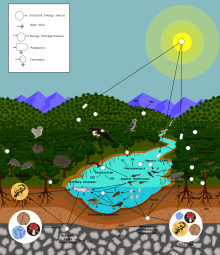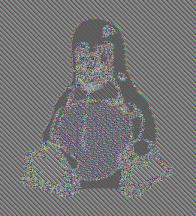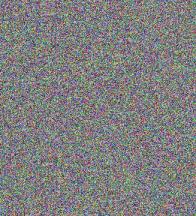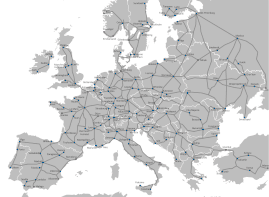User:Mesoderm/sandbox

The current area of focus is:
- Fertilization-->Gastrulation-->Neurulation-->Nervous system-->Neurotoxins
- Peer-to-peer -- Wireless mesh networks -- Distributed computing
- Spanish slavery of indigenous people?
- Slavery was present in Alabama before it became a state (when the region was still part of the Alabama/Mississippi Territory)
Reconstruction and the Jim Crow era
[edit]
References
[edit]- "Slavery", Keith S. Herbert; Encylopedia of Alabama (Auburn University); August 5, 2009
Indigenous Alabama
[edit]- focus on several prominent examples of different p2p apps, but move most of them to a separate list page ("List of P2P applications" or something) ... select small # of apps (freenet, kademlia, napster, bittorrent, skype/voip, chord, etc.)
- write blurb re: applications in article intro
After lead, and before basic definitions, we need an "introductory example" section
Introductory remarks
[edit]A graph is a collection of objects called vertices (or nodes), along with a set of edges connecting pairs of these nodes to each other, based on some kind of relationship.
Graphs can be used to model a wide variety of problems across many domains - in particular, any domain where one is trying to study interactions between large, complex collections of discrete objects that are pairwise related or connected to each other.

Take for example the following problems:
- A network administrator trying to efficiently direct traffic on a communications network
- Logistics personnel shipping cargo throughout a country by rail
- An intelligence agency performing social network analysis to map out hostile online communities and target influential individuals
- An ecologist mapping the flow of energy/nutrients through a complex food web[2]
All of these systems can be modeled as weighted, directed graphs (described below). In a graph representing the communications network the nodes might represent routers, and the edges would describe connections between routers and the speeds of these connections. On the other hand, in a graph modeling a cargo shipping network the nodes might represent individual cities, while the edges represent the costs of sending goods between two particular cities. But in both cases, we use essentially the same mathematical tools.
Likewise, both the intelligence agent and the ecologist might utilize graph clustering methods to identify important groupings of nodes ...

Refs
[edit]prisons
[edit]The social role of prisons
[edit]This section needs expansion. You can help by adding to it. |
Privatized / for-profit prisons
[edit]This section needs expansion. You can help by adding to it. |
Race, class, and mass incarceration
[edit]This section needs expansion. You can help by adding to it. |
Military prisons and internment/concentration camps
[edit]This section needs expansion. You can help by adding to it. |
- Menstrual cycle
- Estrogen
- Progesterone
- Luteinizing hormone
- Follicle-stimulating hormone
- Follicular phase
- Ovulation
- Luteal phase
... articles above need to be written from non-anthropocentric perspective (with exception of Menstrual cycle etc that are actually about human bio). Human reproductive biology should be in articles titled like "Ovulation in humans" ... and then WP:SUMMARYed in the article Ovulation in a section called "Humans" ... and so on
... a diagram or photo series is need for the "ovulation" article
...
Herbal
[edit]- Ethnobotanical data
- Commonly used preparations, and their mode of operation-
- Studies on effectiveness/safety/etc.
- Modern pharmaceutical derivatives
- Thujone (wormwood, yarrow, tansy, etc.)
- Dong quai
- Progesterone <---> Vitamin C ?
- Cotton root
- Blue cohosh
- Pennyroyal
Pharmaceutical industry
[edit]- Major manufacturers of common brands, usage stats, sales $$$, mechanism, health effects
- Embryo
- Embryogenesis -- start here, and break off into sub-articles as gets too long
- Blastula
- Chordamesoderm
- Mesoderm
- Somites / Somitogenesis
- Better images/diagrams (SVG) needed for many embryology articles ... it's learn Inkscape time
Some refs
[edit]- http://www.theodora.com/anatomy/embryology_index.html
- [1] -- good start for some ideas for graphics.
- Good diagram for everything up to glastulation is Figure 1.2 here
- [2] -- good stuff
- Lead
- Process
- Context: Overview of blastula/cleavage/fertilization (in 1 paragraph)
- Loss of symmetry
- Amniotes --primitive streak (mammals, birds, reptiles)[3] [4]
- Formation of primitive streak [5]
- "Primitive streak early avian gastrula"
- Ingression -- cells ingress into primitive streak/primitive node
- Evolutionary development (triploblasts, chordates)
- Differences in gastrulation process in various species (definitely cover sponges, mice, humans)
- Overview of place/role in Embryogenesis
- Germ layers and role of each
- [6] -- "dynamic process, that proceeds from anterior-to-posterior"
- [7]
- [8] -- This one's already cited in the article, but there is a lot more you can get from it (and a lot of overly-detailed stuff from it that should be tossed for the more essential parts)
- [9] -- anterior margin marks beginning of gastrulation ... etc.
- "Gastrulation movements"
- [10]
- [11] - "Early gastrulation"
- [12] "Covergence and extension movements"
- [13]
- [14] -- excellent comparative description of neurulation/induction in various species ...
- [15] -- mouse gastrulation
- [16] -- Wnt signaling
- [17] -- talks about chordates vs. other critters and how their early embryogenesis is diff.
- [18] -- "final result is similar in all species -- three layers"
- BMP signaling neurulation ectoderm ... [19][20]
- [21] -- sea urchin gastru ... great diagram on next page too


- Good diagram ... should have multiple cells shown though ... many more here
- In the general structure section, make sure that you cover the .... ummmm ... most general parts first. So don't start talking about simple vs. stratified, until you've covered what they've all got in common (basement layer, tight junctions, desmosomes, innervated/avascular, cytokeratin proteins, etc.)
- Take Table of simple epithelium types content back into articles and delete template.
- Pseudostratified and transitional epithelium should be mentioned as special cases for simple and stratified epithelia respectively. However, squamous, cuboidal, and columnar should just be mentioned once (make drawings for each of these shape types -- simple, simple to do)
- Also, make sure that each of the types of epithelia are linked to (e.g. simple squamous epithelium, etc. etc.)
- Figure out how to get rid of the big table of "Locations". Maybe make an "Appendix" at Epithelium/Appendix? Is that legal? :)
- Create article List of epithelial tissues consisting of an intro and the table
- You might as well integrate the "Functions" and "Types of epithelia" section into one -- since you're going to have to talk about different functions for each type anyway ...

Ecology
[edit]
Modes of operation
[edit]A block cipher by itself allows encryption only of a single data block of the cipher's block length. When targeting a variable-length message, the data must first be partitioned into separate cipher blocks. Typically, the last block must also be extended to match the cipher's block length using a suitable padding scheme. A mode of operation describes the process of encrypting each of these blocks, and generally uses randomization based on an additional input value, often called an initialization vector, to allow doing so safely.[3][4] We will now discuss 4 standard block cipher modes of operation -- ECB, CBC, CFB, and OFB -- and the strengths and weaknesses of each of them.[5]
Electronic codebook (ECB)
[edit]
The simplest of the encryption modes is the electronic codebook (ECB) mode. The message is divided into blocks and each block is encrypted separately.
The disadvantage of this method is that identical plaintext blocks are encrypted into identical ciphertext blocks; thus, it does not hide data patterns well. In some senses, it doesn't provide serious message confidentiality, and it is not recommended for use in cryptographic protocols at all. A striking example of the degree to which ECB can leave plaintext data patterns in the ciphertext is shown below; a pixel-map version of the image on the left was encrypted with ECB mode to create the center image, versus a non-ECB mode for the right image.

|

|

|
| Original | Encrypted using ECB mode | Modes other than ECB result in pseudo-randomness |
The image on the right is how the image might appear encrypted with CBC, CTR or any of the other more secure modes—indistinguishable from random noise. Note that the random appearance of the image on the right does not ensure that the image has been securely encrypted; many kinds of insecure encryption have been developed which would produce output just as 'random-looking'.
Cipher-block chaining (CBC)
[edit]
In the cipher-block chaining (CBC) mode of operation each block of plaintext is XORed with the previous ciphertext block before being encrypted. This way, each ciphertext block is dependent on all plaintext blocks processed up to that point.
Also, to make each message unique, an initialization vector (IV) must be used in the first block. An IV is a block of bits that is used by several modes to randomize the encryption and hence to produce distinct ciphertexts even if the same plaintext is encrypted multiple times, without the need for a slower re-keying process. An IV has different security requirements than a key, so the IV usually does not need to be secret. However, in most cases, it is important that an IV is never reused under the same key. For CBC and CFB, reusing an IV leaks some information about the first block of plaintext, and about any common prefix shared by the two messages.[6]
If the first block has index 1, the mathematical formula for CBC encryption is
while the mathematical formula for CBC decryption is
CBC has been the most commonly used mode of operation. Its main drawbacks are that encryption is sequential (i.e., it cannot be parallelized), and that the message must be padded to a multiple of the cipher block size. One way to handle this last issue is through the method known as ciphertext stealing. Note that a one-bit change in a plaintext or IV affects all following ciphertext blocks.
Cipher feedback (CFB)
[edit]
The cipher feedback (CFB) mode, a close relative of CBC, makes a block cipher into a self-synchronizing stream cipher. Operation is very similar; in particular, CFB decryption is almost identical to CBC encryption performed in reverse:
CFB, OFB and CTR modes do not require any special measures to handle messages whose lengths are not multiples of the block size, since the modes work by XORing the plaintext with the output of the block cipher. The last partial block of plaintext is XORed with the first few bytes of the last keystream block, producing a final ciphertext block that is the same size as the final partial plaintext block. This characteristic of stream ciphers makes them suitable for applications that require the encrypted ciphertext data to be the same size as the original plaintext data, and for applications that transmit data in streaming form where it is inconvenient to add padding bytes.
Output feedback (OFB)
[edit]
Like CFB output feedback (OFB) mode makes a block cipher into a synchronous stream cipher. It generates keystream blocks, which are then XORed with the plaintext blocks to get the ciphertext. Just as with other stream ciphers, flipping a bit in the ciphertext produces a flipped bit in the plaintext at the same location. This property allows many error correcting codes to function normally even when applied before encryption.
Because of the symmetry of the XOR operation, encryption and decryption are exactly the same:
Each output feedback block cipher operation depends on all previous ones, and so cannot be performed in parallel. However, because the plaintext or ciphertext is only used for the final XOR, the block cipher operations may be performed in advance, allowing the final step to be performed in parallel once the plaintext or ciphertext is available.
Multiple watchlists
[edit]- Issues w/ current situation
- If you've got a very large watchlist, it makes it very difficult to catch interesting changes amidst all the noise.
- Makes it less likely that will watch some pages, even if I probably should, because I don't want to clutter my watchlist
- What would mult. lists let us do
- Could create temporary watchlists for pages that you've recently fixed vandalism on, etc, but don't want to watch forever.
- Could organize watchlists by topic, so only have to watch articles in subject you're currently interested in
- Place high priority items in one watch-list, and low priority in another
- Could create separate lists for User/Template/Project from Article namespace.
- Could have public/private watchlists
- Problems with implementation
- Here it says that the problem has to do with the way the DB tables are set up ... 31 million rows, hard to alter.
- Major past discussions
- Technical
Other articles that need work
[edit]- Amplification
- Oil and gas production
- Malaria
- Gel electrophoresis
- Genetic engineering
- Polymerase chain reaction
- Recombinant DNA
- Sickle cell anemia
Footnotes
[edit]- ^ Martin, David (1993). "The Birth of Jim Crow in Alabama 1865-1896" (PDF). National Black Law Journal. 13 (1): 184–197.
- ^ "Ecological subsystems via graph theory: the role of strongly connected components". Oikos. 110 (1): 164–176. July 2005.
{{cite journal}}: Unknown parameter|authors=ignored (help) - ^ Handbook of Applied Cryptography. CRC Press. 1996. ISBN 0-8493-8523-7.
{{cite book}}: Unknown parameter|authors=ignored (help) - ^ "Block Cipher Modes". NIST Computer Security Resource Center.
- ^ The Block Cipher Companion. Springer. 2011. p. 65. ISBN 9783642173417.
{{cite book}}: Unknown parameter|authors=ignored (help) - ^ B. Moeller (May 20, 2004), Security of CBC Ciphersuites in SSL/TLS: Problems and Countermeasures














